The Intel Core Ultra 7 155H Review: Meteor Lake Marks A Fresh Start To Mobile CPUs
by Gavin Bonshor on April 11, 2024 8:30 AM ESTASUS Zenbook 14 OLED UX3405MA: Rendering & Simulation Performance
Rendering tests are often a little more simple to digest and automate than others. All the tests give out some sort of score or time, usually in an obtainable way that makes it fairly easy to extract. These tests are some of the most strenuous in our list due to the highly threaded nature of rendering and ray-tracing, and they can draw a lot of power. Power isn't so much a problem on mobile platforms, but rendering performance and how it relates to varied workloads such as video editing, is still a vital part of overall performance.
Different from rendering, in our Simulation section, these tests act more like synthetic benchmarks but, at some level, are still trying to simulate a given environment.
For this review, we have included the AMD Ryzen 9 7940HS, which includes the same Radeon 780M integrated graphics, along with the Ryzen 5 8600G, which uses the AMD Phoenix mobile architecture but is adopted for desktops. This allows us to show more data points for our review of Intel's Meteor Lake-based Core Ultra 7 155H to see where performance lies.
Despite including AMD's Phoenix-based Ryzen 8000G APUs in our results, as we expand our list of notebooks tested, we'll have more effective and comparable data points in the future. To add more reference, all of the chips have been tested with Windows 11 22H2.
Rendering
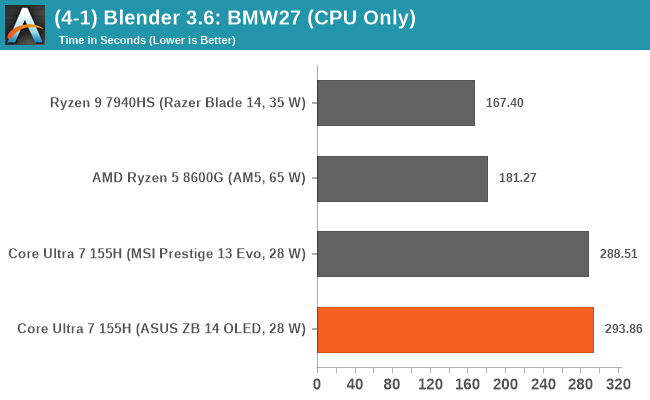
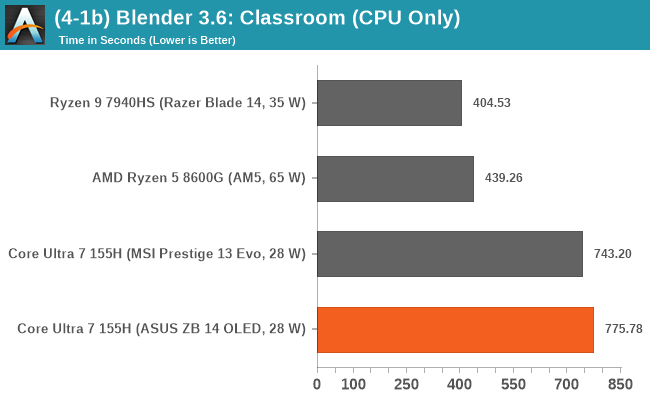
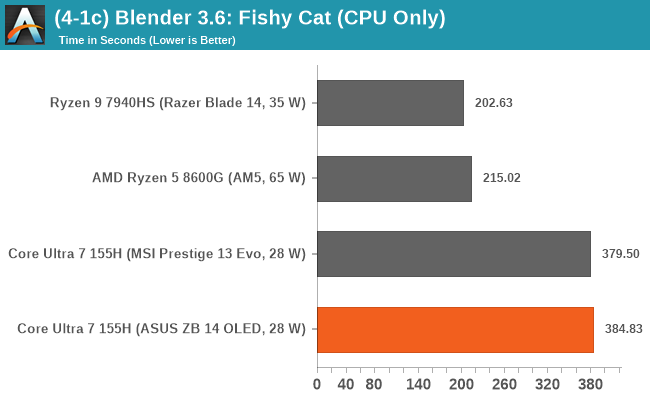
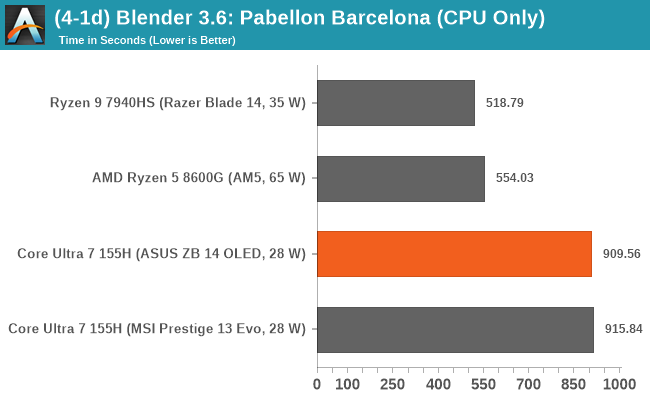
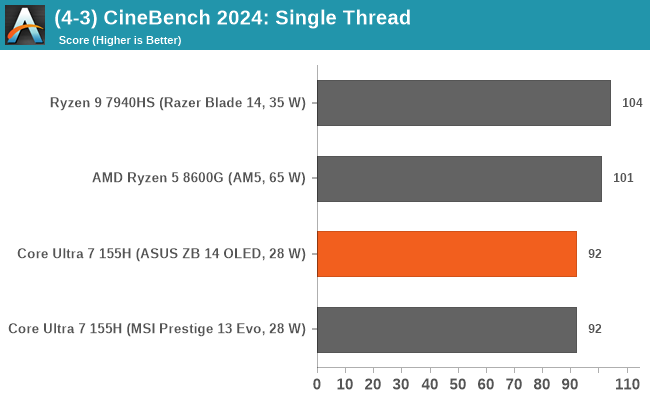
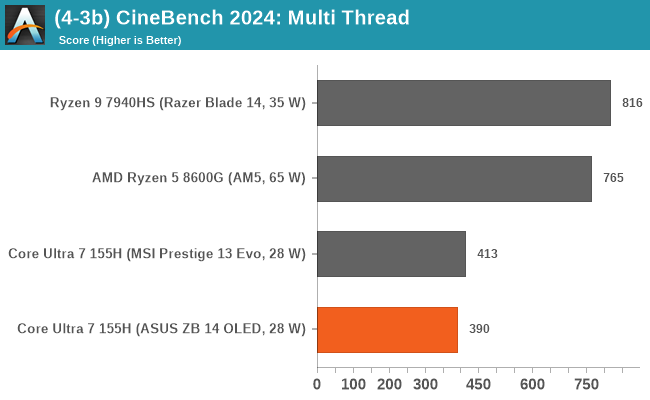

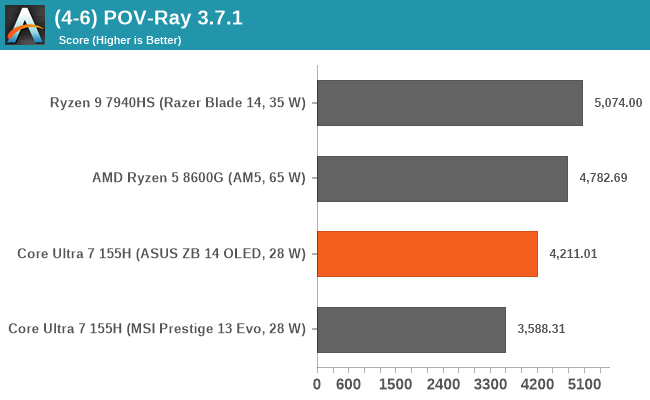
As we can see from our rendering results, the Intel Core Ultra 7 155H is quite competitive in single-threaded performance and is a little behind AMD's Zen 4 mobile Phoenix-based Ryzen 9 7940HS. The situation changes somewhat when we move to multi-threaded performance, with the Meteor Lake notebooks lagging behind in all Blender 3.6 tests. Things look better in our POV-Ray test, with a competitive showing, and there is a similar situation in the V-Ray benchmark.
Simulation
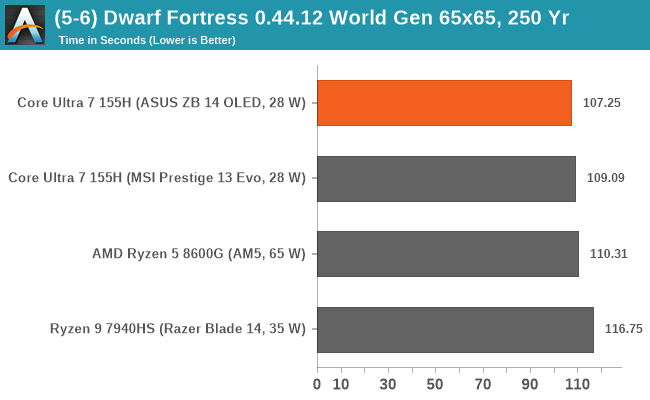
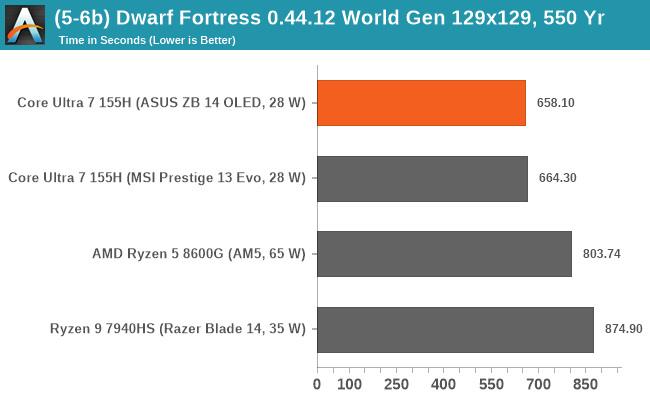

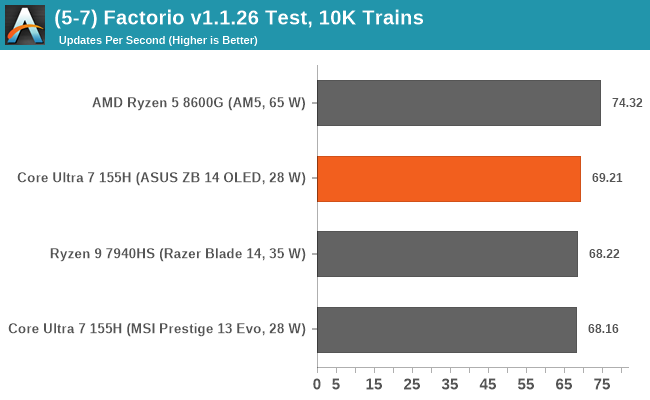
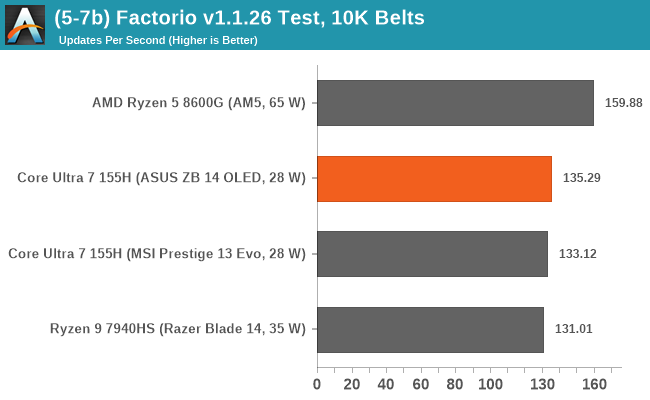
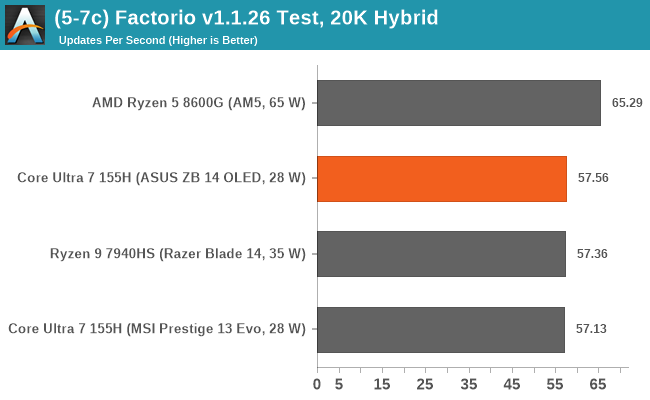
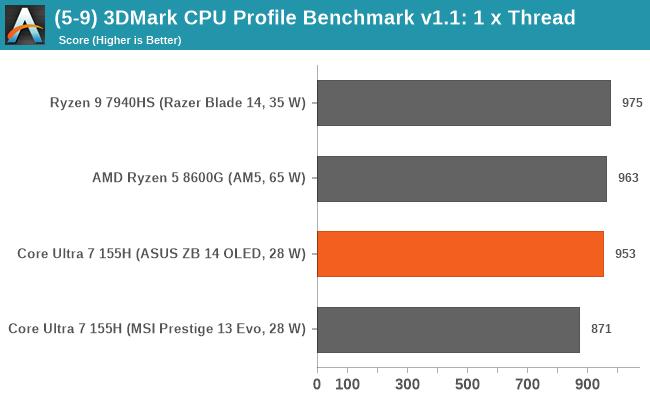
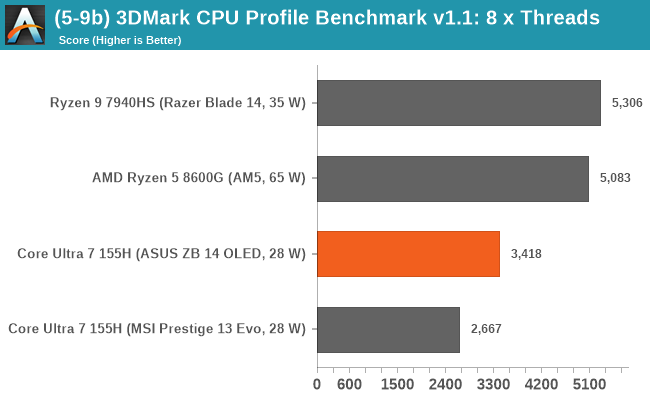

Our simulation benchmarks show that the Intel Core Ultra 7 155H outperforms the Ryzen 9 7940HS and even the desktop Ryzen 8000G series processors in Dwarf Fortress. In our Factorio tests, Meteor Lake is also very competitive with the AMD Phoenix-based chips, although the AMD chips perform better in the 3D Mark CPU profile with maximum threads.










69 Comments
View All Comments
Ryan Smith - Thursday, April 11, 2024 - link
"Also the official title is CPU review and there are graphs for BATTERY CHARGE TIME ??? Really ? What does that have to do with the CPU at all ?"With these integrated devices, we're reviewing the notebook as much as we're reviewing the chip inside. And in any case, battery life/recharge testing is very straightforward and is something that can be run overnight, so it doesn't get in the way of other testing. Reply
haplo602 - Friday, April 12, 2024 - link
Sure, but then the title should be "Review of 155H and the ASUS Zenbook 14". If it is a CPU review, then the other tests are irrelevant. If it is a device review, then there are things missing.Currently it poses as a some kind of strange hybrid while the title says only CPU review. Basically the content does not match the label on the box ... Reply
mode_13h - Monday, April 15, 2024 - link
> Intel has a huge advantage with LPDDR5X here that it manages to waste somehow.LPDDR5 and 5X are both much higher-latency than regular DDR5. That probably explains some of the performance vs. expectations mismatch. Reply
timecop1818 - Thursday, April 11, 2024 - link
what's with the trend of removing INS key and replacing it with a camera or power or some other useless button. this is getting ridiculous. i use shift-ins to paste all the time, and there are plenty of times when i want to overwrite something without caring to select it, thus needing an ins toggle. what the hell? is this some new crap mandated by the Microsoft ai button initiative? Replysylwah - Thursday, April 11, 2024 - link
From the inconsistencies between benchmark results and the text, to the comparison between latest Intel and previous gen AMD and the article title, this is clearly paid advertising by either Asus or Intel.Journalism guidelines say paid content should be disclosed, and yet I see it nowhere in the article. Feels like a new low. Reply
Orfosaurio - Thursday, April 11, 2024 - link
Maybe, but there is the presumption of innocence. ReplyRyan Smith - Friday, April 12, 2024 - link
"this is clearly paid advertising by either Asus or Intel."This is not a paid article in any shape or form. We have not received a dime from any party for this review.
To be clear, Intel did supply the Asus laptop for review purposes - as they usually do for mobile-first CPU launches - and we sourced the MSI laptop separately so that we could have a second data point. Reply
jeenam - Friday, April 12, 2024 - link
The benchmarks don't paint the Intel chip in a positive light. I agree with your assessment. The first thing I checked was the Graphics benchmarks as I recently purchased a 7840HS which has the Radeon 780M iGPU. It would seem Company of Heroes and Returnal were cherry-picked for the GPU benchmarks just so it would appear the integrated Intel ARC GPU isn't a dog compared to the 780M.Any objective reader who simply went on benchmarks would make the following honest assessment:
- The Intel ARC GPU is a dog compared to the 780M
- General benchmark performance indicates the Intel chip getting smoked by Ryzen 4
- The one area where Intel has an advantage is battery life
It's obvious the GPU benchmarks included games that were cherry-picked to give the appearance that the Intel ARC GPU can actually be competitive, when most likely if you were to pick a typical suite of games for benchmarking (e.g. GTA V, RE4 Remake, Forza, CS2, etc.) the losses to the 780M would continue to pile up. Reply
Ryan Smith - Friday, April 12, 2024 - link
" It would seem Company of Heroes and Returnal were cherry-picked for the GPU benchmarks just so it would appear the integrated Intel ARC GPU isn't a dog compared to the 780M."To be clear, the benchmarks were picked before we had the hardware. There's a lot of calculus that goes into selecting software for the benchmark suite, but the big things are suitability as a benchmark (i.e. does it even have a benchmark mode), popularity, and performance scalability.
Even then, we kind of whiffed it in the end, as Returnal doesn't break 30fps on current iGPUs. Reply
Hulk - Friday, April 12, 2024 - link
It's a great review and I appreciate it. Reply